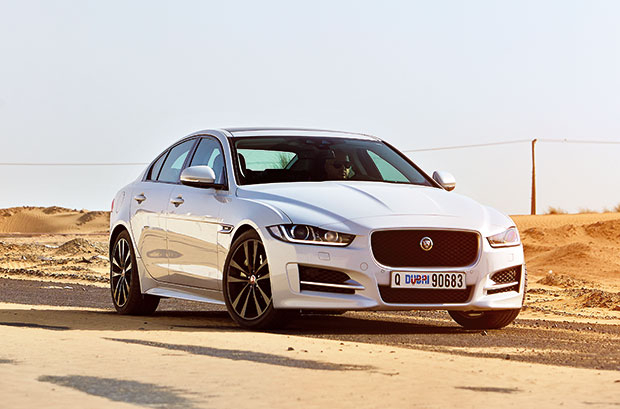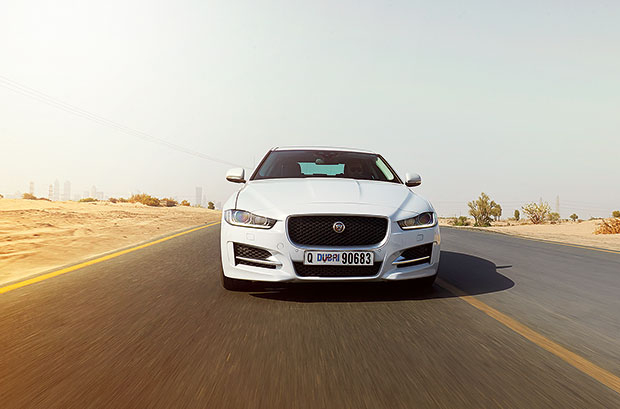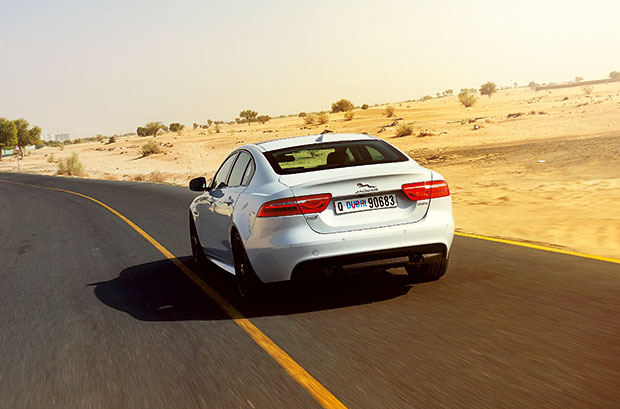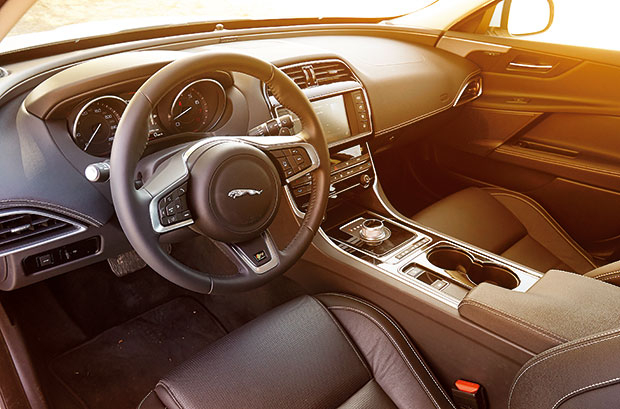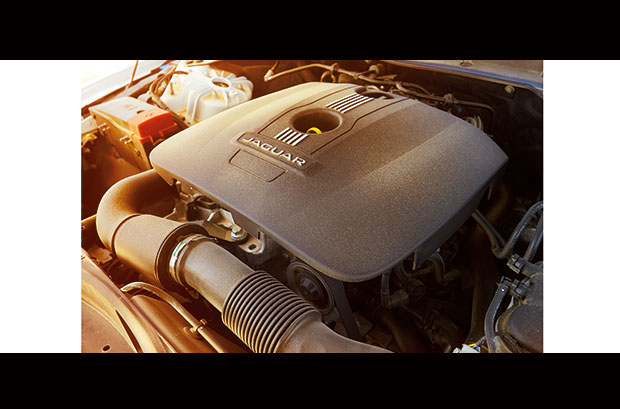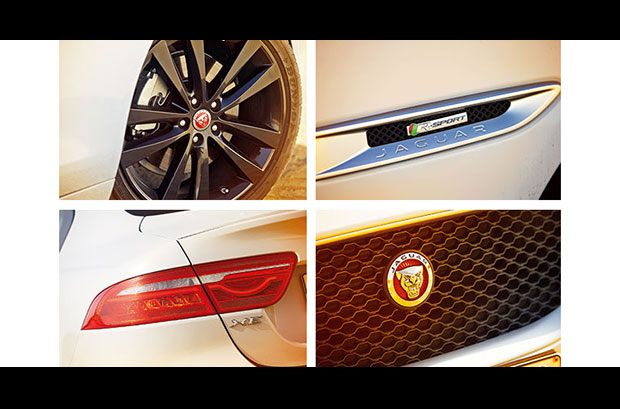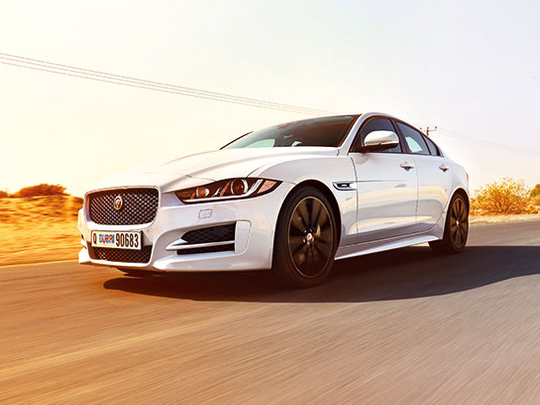
Exactly a year ago, I endured one of the most bizarre car launches ever. The venue was Earls Court, London. The car was the XE. And the launch? An over-the-top theatrical production about a time-travelling boy and his mates who set out to create the Jaguar of 2015. Elaborate, yes. Good? No. Performances from Emeli Sandé and the Kaiser Chiefs prolonged the agony of it all.
The resulting press wasn’t favourable and many felt it could be an indication of how the newbie would be perceived — badly. JLR couldn’t afford its mid-size saloon to be a failure, not when it’d spent over Dh8 billion on a new production facility to build it.
It won’t admit to it, but its future is riding on the executive saloon. A total of 80,000 sales in 2014 is not a number of a major global player. JLR need the XE to be a hit. But being thrust into one of the most competitive segments, which includes the 3 Series, C-Class, A4 and IS, the baby Jag has the weight of the world on its little shoulders. Now, having driven the XE, in R-Sport guise, can it live up to hefty expectations?
Absolutely. It’s buried the ghost of the ghastly Mondeo-based X-Type — the last time Jag offered a BMW, Mercedes, Audi and Lexus rival — and follows up the sporty F-Type and elegant XF with such aplomb that it’s clear there’s plenty of life left in the Coventry carmaker.
Our tester, resplendent in Glacier White paint and riding on 19in Venom 5 twin-spoke black alloys, looks like it could easily mix it with its German and Japanese counterparts. It sticks to the style of its almost decade-old bigger XF brother, but a slightly shorter boot and lower roofline helps differentiate the two.
It also has a very impressive drag coefficient of 0.26, making it the most aerodynamic Jaguar ever. With an aggressive front end plastered with large air intakes, chrome side vents and a discreet spoiler at the rear, it’s clear that the XE isn’t a pushover.
Those vents up front help stabilise airflow over the front wheels and it has underfloor panelling that smooths the airflow below the car. It offers a hint of the sporty coupé around the rear, particularly the taillights, and like the rest of the clan, this one too is suave and sophisticated. What’s more, its body shell is 75 per cent aluminium and weighs just 251kg. Jag says it has better torsional stiffness than its rivals.
The 2.0-litre four-cylinder turbocharged motor has 236bhp and 340Nm of torque, and it really begins to make itself known above 4,000rpm. It’s one of those cars that gets better the faster you drive; it revs smoothly and delivers its power with a pleasing response, but the nonchalance in which the chassis copes with the grunt and translates it to the road is the best thing about this particular model.
The bigger, heavier and more purposeful supercharged V6 would give the double wishbone front and integral link rear suspension more to think about, but tasked with manning the four-pot — which weighs just 138kg and is mated to a ZF eight-speed automatic with wheel-mounted paddle shifts — it delivers a supple, comfortable ride, but definitely has a sportier side to it.
Throttle response is good, particularly in Dynamic mode, and when you floor it, you get a smooth surge of power. It excels on winding roads and there’s a number of reasons why; the electronic power steering is, for me, one of the best in class.
With a crisp response, perfect weight and very good feedback, it makes a solid first impression the moment you hop in and set off. I’ve always preferred a hydraulic system but the XE delivers the most natural and consistent feeling I’ve found in an electric set-up.
That may be because the four-pot isn’t weighing the front end down much — certainly not as much the V6 would — and so with less load on the front wheels, it feels sharper and more eager to turn in. It’d be interesting to see how the XE’s dynamics change (if at all; the electric power steering is a clever piece of kit that can compensate for changes in road camber, keeping the car firmly on track) with the larger engine.
From the steering feel alone, you can tell the rest of the chassis is going to be good. And, it proves so. The front suspension is the same double wishbone as the F-Type and, coupled with a set of tuned dampers, gives the XE a smooth ride, which Jaguars are renowned for, not to mention taut body control (the shocks and springs are stiffer in the R-Sport) and agile handling that allows you to be quite aggressive with the car.
There’s no segment standard conventional multilink to be found here; that lightweight aluminium intensive integral rear link, which is usually found in bigger and more expensive cars, plays a major role in the XE’s robust handling.
Jaguar says it is the most sophisticated rear suspension in class. It sure delivers a precise and dynamic ride. Stopping power comes from lightweight callipers and large discs (the ventilated front anchors have enhanced cooling thanks to suspension-mounted ducts that channel air to the centre of the discs), but perhaps the most impressive feature is the torque vectoring system; it alleviates understeer by gently braking individual inner wheels when need be and this helps to keep the car on the optimum line through corners.
So, with properly good steering, suspension and brakes, I’d have to say this is one of the most willing chassis, free of any carryover components, in its class.
Can it set new benchmarks for ride and handling? It has the capability to do so. A shoot-out with its rivals is already in the works and we’ll be keen to find a definitive answer. What’s clear is that the XE seeks out the corners and then hungrily devours them while keeping body roll to an absolute minimum.
The ride is firm but not harsh, and to be able to strike such an intricate balance speaks volumes about the amount of time and effort Jaguar engineers put in to achieve this. That Dh8 billion suddenly seems well spent.
Fire it up with a push of a button and the brand’s familiar rotary gear selector rises majestically from the wide centre console. The dash is laid out well and it’s all pretty intuitive. The driving position is good too and the seats, trimmed with Taurus leather in the R-Sport, are comfortable and offer good support when you’re really gunning it.
However, it takes a little while to get used to the throttle and brake as they’re a touch too close together, while the chunky B-pillar causes pretty big blind spots. Ingress and egress suffer due to the low roofline and there’s a rather large transmission tunnel taking up valuable space for back-seat passengers.
There’s not much else to complain about in the cabin, which has good fit and finish (it mimics the XJ’s swept-around powerboat-style cockpit) and boasts JLR’s new 8.0in touchscreen interface.
It works fine but can be tricky to operate, especially on a bumpy road; with your finger wagging aimlessly you’ll end up pressing everything but for the button you want. BMW’s iDrive, therefore, still leads the way in this department, but the XE will run the 3 Series very close in what really matters to drivers — and that’s the drive itself.
It’s not often things live up to expectations. Fortunately for Jaguar, this is most definitely one of those times. The XE looks like it’ll more than hold its own against some formidable opposition.
Hopefully, the next time Jaguar launches a car, it’ll simply hire a celebrity to pull the covers off of it. You don’t need such a big spectacle, especially not when the cars Jaguar is currently producing can speak for themselves.


